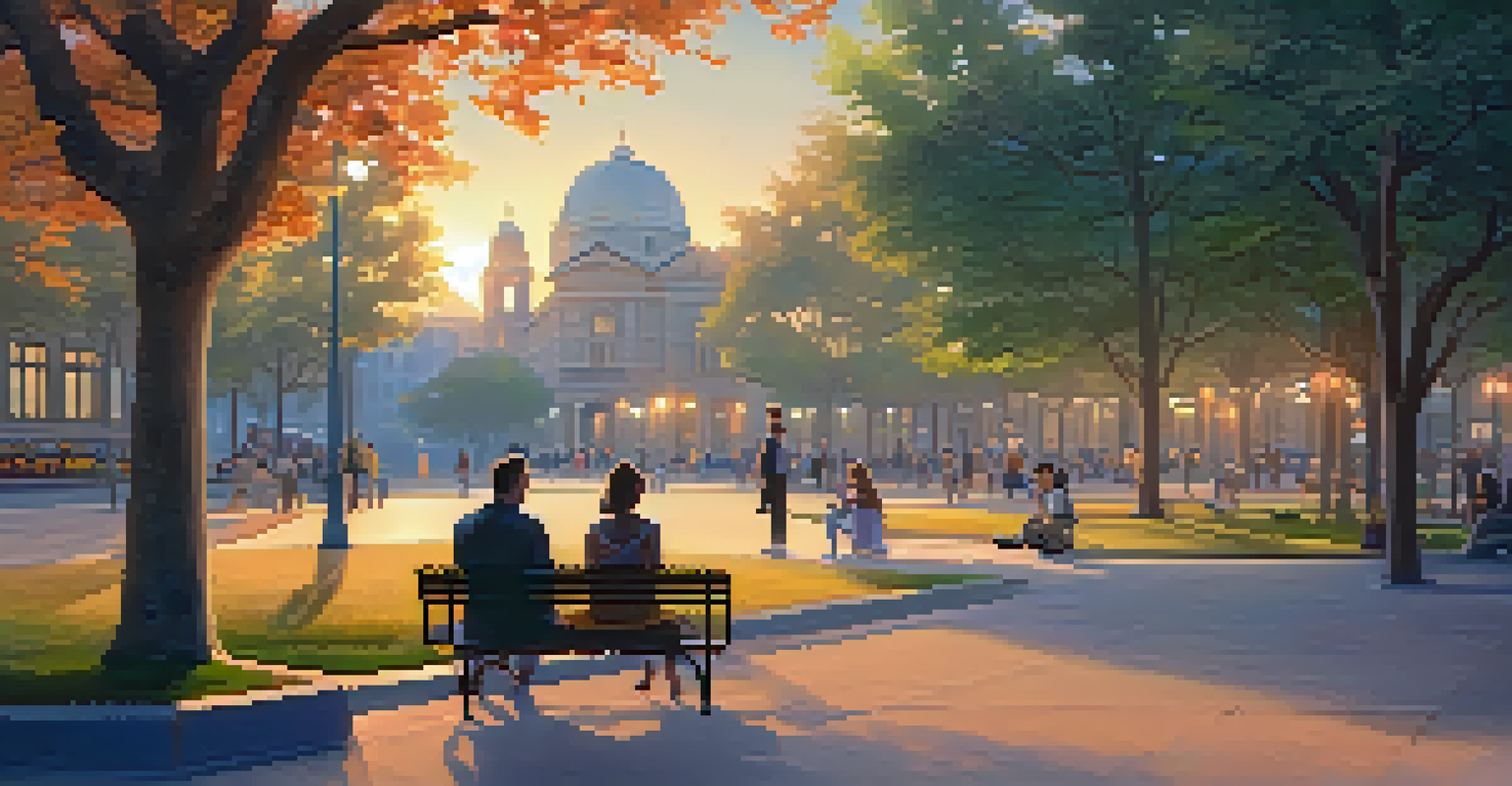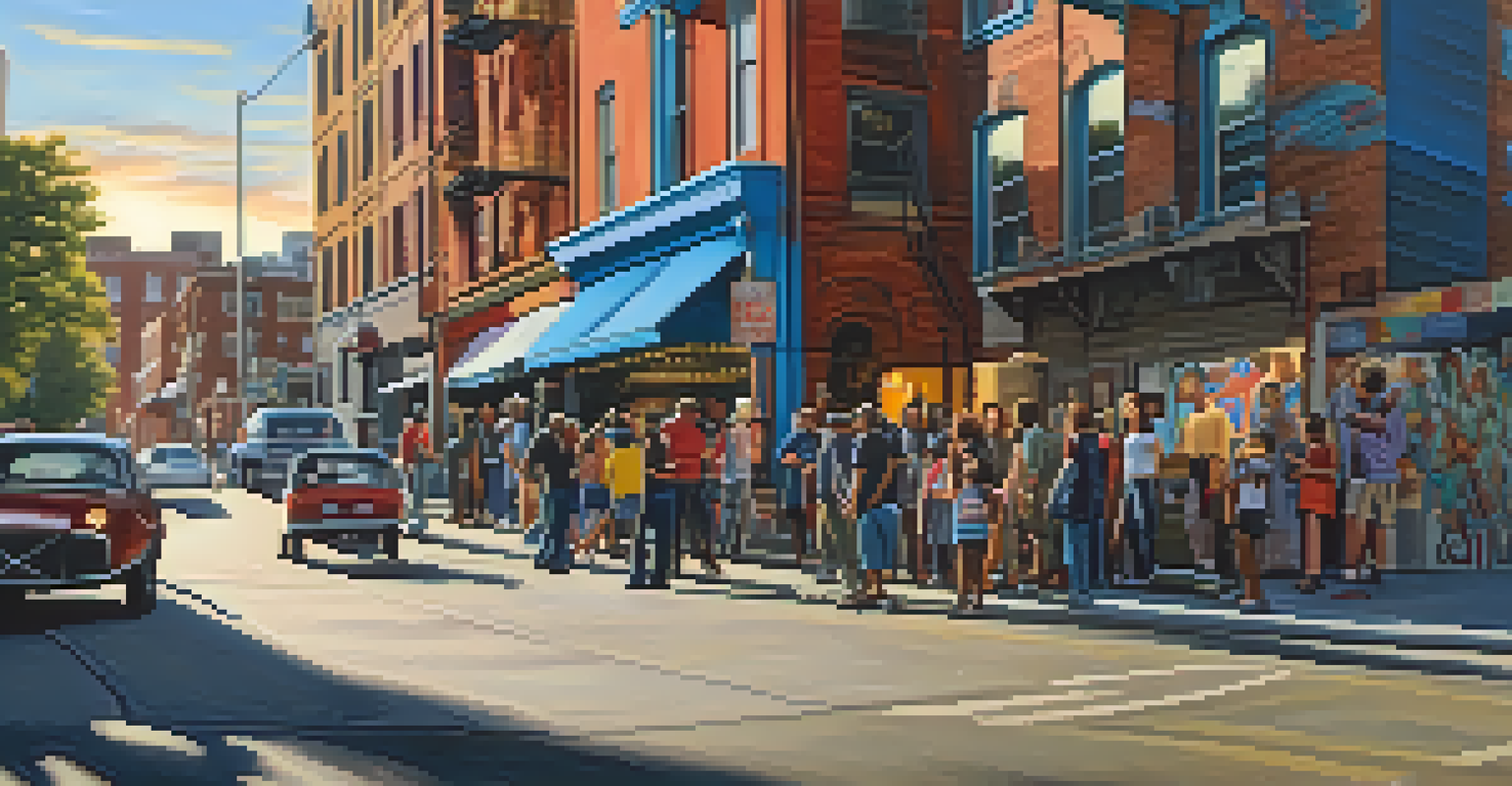The Relationship Between Music and Urban Public Spaces

Understanding the Role of Music in Urban Environments
Music has always been a vital part of human culture, and its presence in urban public spaces adds a unique layer to city life. Streets, parks, and plazas often come alive with sounds that reflect the community's identity and vibrancy. This melodic backdrop not only enhances the aesthetic appeal but also influences how people interact with these spaces.
Music is the shorthand of emotion.
When we think about urban environments, we often envision bustling streets filled with cars and crowds. However, the music echoing through these areas can transform them into lively venues for social interaction and creativity. It invites people to linger, explore, and connect with one another, fostering a sense of belonging in the city.
Moreover, music serves as a universal language that transcends barriers, drawing together diverse groups of people. Whether it's a street performer playing a guitar or a public concert featuring local artists, these musical moments can create shared experiences that strengthen community bonds.
The Impact of Live Music Events on Public Spaces
Live music events in urban settings, such as concerts and festivals, can significantly alter the atmosphere of public spaces. These gatherings not only attract large crowds but also encourage people to engage with their surroundings in new ways. Parks and squares become stages for creativity, transforming them into lively hubs of activity.

These events can also stimulate local economies by bringing in visitors who shop, dine, and explore the area. For instance, a summer music festival may lead to increased foot traffic in local restaurants and shops, benefiting the entire community. This symbiotic relationship between music and commerce highlights the importance of public spaces for both cultural and economic growth.
Music Enhances Urban Engagement
Incorporating music into urban spaces fosters social interaction and a sense of belonging within the community.
Furthermore, live music fosters a sense of pride and ownership among residents. When people see their local artists performing in their neighborhoods, it creates a connection to the space that goes beyond mere geography. This emotional relationship can lead to increased advocacy for the preservation and enhancement of these public areas.
Music as a Tool for Urban Revitalization
Urban revitalization is a process that aims to improve neglected or declining areas, and music plays a crucial role in this transformation. By incorporating music into community planning, cities can breathe new life into forgotten spaces. This could involve hosting regular performances or creating designated areas for musicians to showcase their talents.
Without music, life would be a mistake.
One great example of this is the transformation of derelict neighborhoods into vibrant cultural districts through music initiatives. These efforts not only improve the aesthetic of the area but also attract new residents and businesses, creating a ripple effect of positive change. Music becomes a catalyst for revitalization, making these spaces more inviting and dynamic.
Moreover, music can help bridge the gap between different community groups, fostering collaboration and inclusivity. When diverse musical styles and cultures are celebrated in public spaces, it encourages dialogue and understanding among residents, ultimately contributing to a more harmonious urban environment.
The Psychological Effects of Music in Public Spaces
The sounds we hear in public spaces can significantly affect our mood and behavior. Studies have shown that music can reduce stress, enhance feelings of happiness, and even encourage social interactions. When people are in a pleasant auditory environment, they are more likely to engage positively with others and their surroundings.
For instance, imagine walking through a park where soothing melodies are playing in the background. This serene atmosphere can encourage visitors to relax, take a moment to appreciate their surroundings, and connect with fellow park-goers. In contrast, a lack of music or an unpleasant sound environment can lead to feelings of discomfort and isolation.
Live Music Boosts Local Economies
Events like concerts and festivals not only attract crowds but also stimulate local businesses and cultural growth.
Additionally, public spaces that feature live music or curated playlists can create a sense of community identity. By including music that resonates with local culture, cities can foster a deeper emotional connection to the space. This connection can encourage people to spend more time in these areas, ultimately enhancing community cohesion.
Music and Cultural Expression in Urban Spaces
Music is a powerful form of cultural expression, and urban public spaces often serve as platforms for this creativity. From street performers to community festivals, these spaces provide opportunities for artists to share their work and connect with audiences. This exchange enriches the cultural fabric of the city, making it a more vibrant place to live and visit.
In many cities, music serves as a reflection of the community's history and diversity. Local genres, traditional songs, and contemporary rhythms can all be heard in public spaces, showcasing the unique cultural landscape of the area. This celebration of musical diversity not only entertains but also educates residents and visitors about the community's heritage.
Furthermore, these musical expressions can empower marginalized voices within the community. By providing a platform for underrepresented artists, public spaces help ensure that a wide array of perspectives and stories are heard and appreciated. This inclusivity fosters a richer understanding of the city's identity and promotes social cohesion.
Challenges of Integrating Music in Urban Public Spaces
While the integration of music into urban public spaces offers numerous benefits, it also presents challenges. Noise pollution is a significant concern, as excessive sound levels can disturb residents and lead to conflict. Striking a balance between vibrant musical expression and the need for a peaceful environment is crucial for urban planners and community organizers.
Moreover, the commercialization of music in public spaces can sometimes overshadow local artists. Large events often prioritize big-name performers, leaving less opportunity for emerging musicians to showcase their talents. This can create a cycle where only the most commercially viable acts are given a platform, undermining the diversity that makes urban music scenes so vibrant.
Music as a Tool for Revitalization
Utilizing music in urban revitalization efforts can transform neglected areas into vibrant cultural hubs.
Another challenge lies in ensuring equitable access to these musical opportunities. Public spaces should be inclusive and accessible to all community members, regardless of socioeconomic status. Addressing these issues requires collaboration among local governments, artists, and community organizations to create environments where music can thrive for everyone.
Future Trends: The Evolution of Music in Urban Spaces
As cities continue to evolve, the relationship between music and urban public spaces is likely to change as well. Technology plays a significant role in this evolution, with advancements such as soundscapes and digital installations creating new ways for people to experience music in public areas. These innovations can enhance the engagement of visitors and create immersive experiences.
Moreover, the rise of community-driven initiatives fosters a greater emphasis on local music and culture. As more neighborhoods prioritize artistic expression, we may see a shift towards more grassroots events that reflect the unique identities of their communities. This trend not only promotes inclusivity but also supports local economies.

Additionally, sustainability will likely become a key focus in the integration of music into urban spaces. Efforts to create eco-friendly events, utilize local talent, and minimize environmental impact can lead to a more responsible approach to public music programming. This evolution will ensure that music remains a vibrant part of urban life while being mindful of the spaces we inhabit.